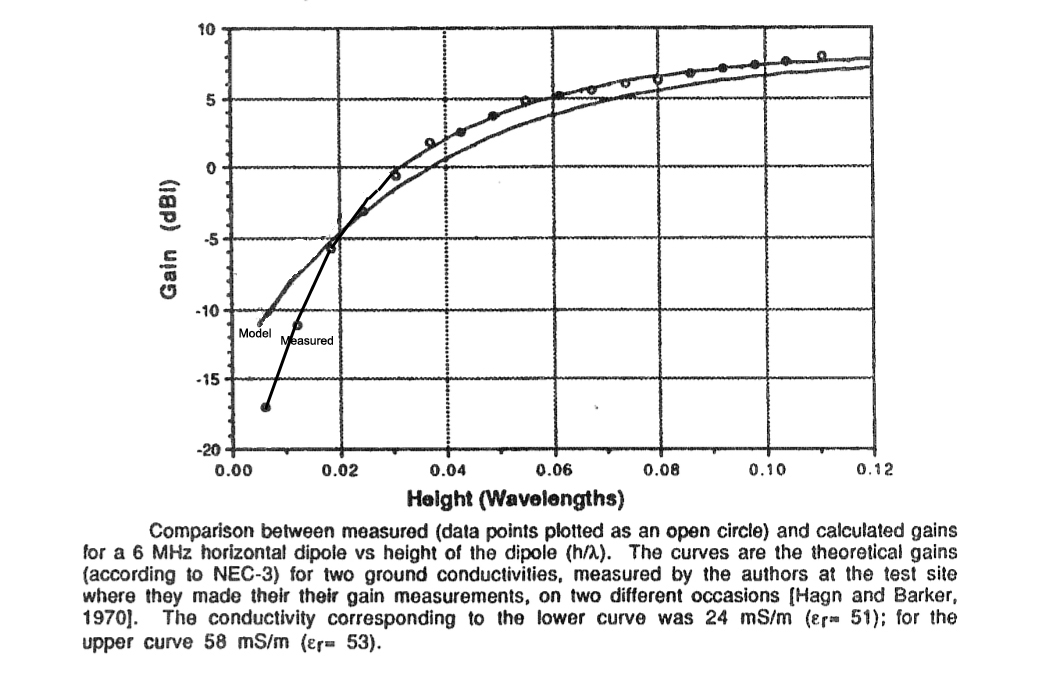
|
NVIS N.V.I.S antenna |
|
|
There are claims circulating that placing an antenna at very low heights enhances NVIS operation, or that an antenna has to be very low to be an NVIS antenna. This is a misconception at best, and an untruth at worst. These claims are based on unsubstantiated rumors, or assuming that because a low antenna was deployed and made contacts, it must be the best way to install a NVIS antenna. For example, if someone digs up some claim the military uses a very low antenna for communication, it must be the best or only way to do things.
N6BV published at least one QST article trying to dispel myths about NVIS. Dean Straw's (N6BV) December 2005 QST article, on page 38, is a good source. Dean is meticulous with his writing.
I've decided to post some actual measured data from a VietNam-era NVIS antenna study by Hagn-baler. The little circles that appear above or below the smooth curves are actual field strength measurements made in 1970 by Hagn and Barker. The data is from actual antenna measurement taken from helicopter flights over the antenna. This data is actual field strength measurements as they compare to NEC-3 predictions. To the best of my recollection, I obtained this data many years ago from my dear friend Walter Maxell.
Compare the measurement points plotted as small circles to NEC-3 curves (the unmarked curved line) that use a slightly different conductivity.
The measured data, represented by circles, is over very good SE Asia rich black jungle soil. This soil is better than soil found in most US locations, thus having less loss.

Notice between .02 wavelength and .12 wavelengths the measured data (circles) matches the computer model closely. At about .02WL the model and measured data depart, with the model being over optimistic by about 6 dB at very low heights.
The optimum height for NVIS antennas is something over 1/8th wavelength, or about 30-35 feet on 75 or 80 meters. Signal level decreases rapidly as height is lower than about .05 wavelength, or approximately 14-feet.
From 1/4 wave high to 1/8th wave high, there is no difference in NVIS
field strength. This would be about 35 feet high on 40 meters or 70 feet high on
75/80 meters.
The OPTIMUM
NVIS antenna height for 80 through 40 meters is about 30-feet!!
Please note the following trends as we decrease antenna height
from ~16 feet on 40 meters, or ~32 feet on 75 meters:
At .06 wavelengths high (16 feet on 80M, 8 ft on 40M) field strength is down 3dB. This is about 50% TX signal reduction.
At .04 wavelength (10 feet high on 80M or 5 ft on 40M) field strength is down 5dB. This is about 2/3 reduction in TX signal level!
At .02 wavelength (5 feet high on 80M, 2.5 ft on 40M) field strength is -5dBi, or -13dB from 0.125 wavelength height. This is 1/20th the optimum transmit signal level!!
At .005 wavelength (1.35 ft high on 80M, or 0.66 ft on 40M ) field strength is down by 25dB. This is about 1/300 optimum transmit signal height signal level!!!
We can reasonably expect, over very good soil, a 5-foot high 75-meter antenna would be down 13dB from an antenna 30-ft high. This would be true at any distance.
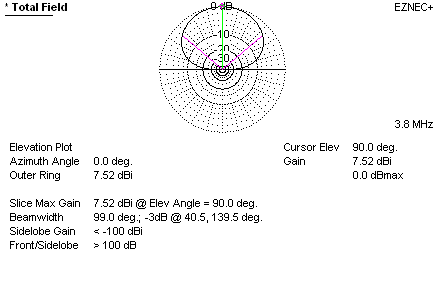
Compare this to +8dBi measured in Thailand. Very good agreement. Now let's move the antenna lower.
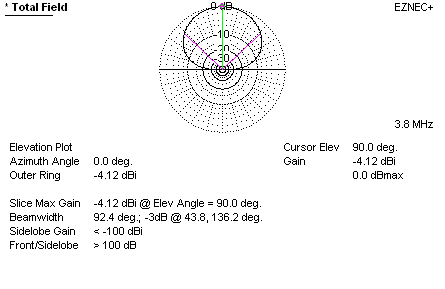
Compare this to -5dBi for the real antenna and we see it is still very good agreement. This shows both the EZNEC+ model and a real measurement agree closely. EZNEC+ tells us we lost 11.6dB while the actual measurements tell us we lost 13dB.
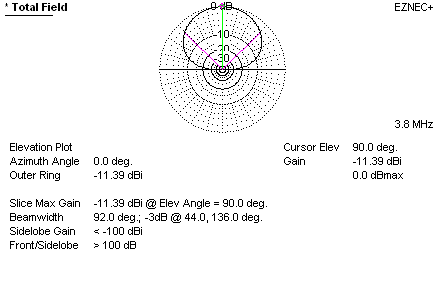
We now see EZNEC+ shows -11.4dBi which is -19.4dB from our 31 foot high antenna. The actual measurement from Thailand shows the signal was down 25dB from the higher dipole. In this case EZNEC+ is overestimating signal strength by about 6dB.
Now here is something to consider. People claim distant signals get weaker and short skip signals get stronger when the antenna is lowered to very low heights. Factually that just isn't true. We have measurements made with sophisticated equipment using helicopters to fly over the antenna area and plot radiation. Those measurements prove we lose considerable signal level on transmitting as the antenna is lowered below .05 wavelength (about 12 feet). We have models that closely agree (except at very low heights).
We also see the pattern hardly changes. If the pattern or directivity hardly changes, the signal-to-noise ratio on receive will not change either. The only difference will be a weaker signal and weaker noise, just like adding an attenuator. The problem is a low antenna kills your transmitting signal, turning a 100W rig into the equivalent of a 1 watt transmitter in the case of a very low antenna.
I'm afraid I have to side with R. Dean Straw's QST article, Hagn-Barker's actual field strength measurements, EZNEC+, and my own experience measuring and using antennas for the past 40+ years.
Please, let's not give silly advice like 5-foot high antennas are good ideas for emergency communications or NVIS operation. Very low antennas produce very low signal levels at any distance when compared to antennas of modest height.
Some claim a screen, counterpoise, or reflector wire grid below a low dipole will not improve signal levels. My own direct experience shows the idea a screen will not improve signal levels is NOT true, and that a counterpoise system can actually improve signal levels. This is true even when the screen or counterpoise is not tuned. On 75-meters, back in the days of 3830 and 3895 radio wars, there was always a definite advantage to stations using low dipole with good screens or counterpoises below the antenna. this was a trick I first earned from W8PSX in Westlake Ohio , where Jim had a counterpoise system below his 160-meter dipole.
Let's look at losses in a low 80-meter dipole over soil like mine:

This antenna with no ground screen has 4.81 dBi gain

One counterpoise wire below antenna.
This antenna has almost 2 dB more signal level.

This antenna, with three untuned ground counterpoise wires, has 3 dB more signal level.
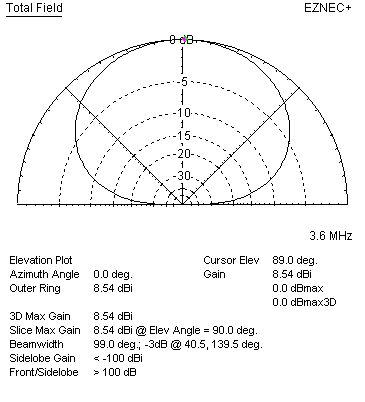
With many counterpoise wires, the model improves 3.7 dB.
It's my belief the actual improvement I saw was around 5 dB in my own systems, although this varies greatly with antenna height and soil conductivity.
G5RV Antenna Efficiency Antennas Home Amplifiers Home My Workshop My Antennas
since 9/23/2006 Copyright W8JI 2006